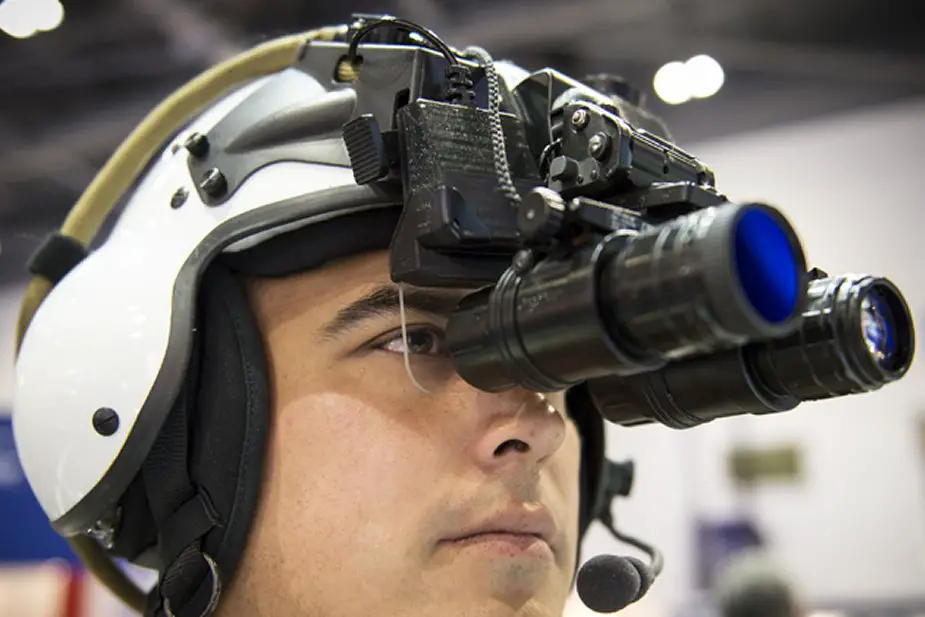According to a press release published by Thales on July 22, 2021, the firm has received an order from the French defence procurement agency (DGA) for 350 Scorpion® helmet-mounted sight and display systems and 400 digital multi-function displays.
Follow Air Recognition on Google News at this link
 Thales Scorpion Helmet Mounted Sight (Picture source: Thales Group)
Thales Scorpion Helmet Mounted Sight (Picture source: Thales Group)
The systems deliver enhanced tactical situational awareness and slave the weapon or mission systems to the pilot’s line of sight to improve the effectiveness of air operations.
This new equipment will further enhance the operational effectiveness of the Rafale F4 standard.
Thales has been awarded the contract to supply Scorpion® helmet-mounted sight and display systems and digital multi-function displays for all the Dassault Aviation Rafale aircraft in service with the French Air and Space Force and the French Navy.
From reconnaissance to air defence and precision strike missions, the Rafale has helped ensure the success of countless military operations. But future aircrews will have to analyse more data in less time on combat missions carried out in increasingly complex environments. Coupled with the aircraft's weapon systems, the Scorpion® helmet-mounted sight and display enhances tactical situational awareness and enables crews to respond more quickly and with greater agility to a whole range of threats. Its progressive rollout on the Rafale F4 standard will be a decisive advantage in ensuring the success of airborne missions and protecting populations.
The helmet-mounted display symbology brings together information from the aircraft’s onboard sensors to help pilots perform their missions even in the most challenging situations. It creates a continuum between the cockpit and the outside world to radically improve awareness of the tactical situation. Coupled with the weapon system, the display can be used to designate and track targets anywhere in the crew's field of view in daylight and at night.
Scorpion® delivers all of these capability enhancements in addition to the protection and survivability functions of a conventional flight helmet. It is optimised for weight and balance to maximise pilot comfort and mission effectiveness.
The 400 digital multi-function displays on order will replace the lateral displays on France's in-service Rafale aircraft, which are primarily used to inform the pilot about the status of the aircraft's systems and provide imagery from its onboard sensors. The new equipment offers a larger display area, an improved touchscreen interface and greater processing power.
The Dassault Rafale is a French twin-engine, canard delta wing, multirole fighter aircraft designed and built by Dassault Aviation. Equipped with a wide range of weapons, the Rafale is intended to perform air supremacy, interdiction, aerial reconnaissance, ground support, in-depth strike, anti-ship strike and nuclear deterrence missions.
The F4 standard is part of the ongoing process to continuously improve the Rafale in line with technological progress and operating experience feedback. The F4 standard marks a new step coming in the wake of the standards F1 (specific to the first aircraft of the French Navy), F2 (air-to-ground and air-to-air capabilities), F3 and F3R (extended versatility).
New functions will be developed to improve the aircraft’s capabilities (upgrades to the radar sensors and front sector optronics, helmet-mounted display capabilities), and new weapons will be integrated (Mica NG air-to-air missile and 1,000-kg AASM Air-to-Ground Modular Weapon).
F4 will include a new Prognosis and Diagnostic Aid System introducing predictive maintenance capabilities. Other maintenance optimization features are scheduled, particularly with solutions based on Big Data and artificial intelligence. Lastly, the Rafale will be equipped with a new engine control unit.
Validation of the F4 standard is planned for 2024, with some functions becoming available as of 2022.
















